Profile
Blog
Photos
Videos
Who's Afraid of the Big Bad Tripe?
Jodi Picoult's advice on love: "What makes a treasure a treasure is how rare a find it is, when you need it the most." - Between the Lines
I skipped breakfast yesterday so I could visit the Uffizi Gallery. Laying in bed Thursday night it occurred to me that Friday morning might be my only opportunity to see the famous art collection. Saturdays were notoriously hellish for tourist attractions, when both locals and travellers often chose to go, and besides, I already had plans to return to Mercato Centrale Saturday morning to buy wine and some more of those mouth-watering candied clementines. I was only in Florence until Tuesday, and Sunday and Monday were Easter holidays (a very big deal in Italy) so there was no telling what would be open.
Online reviews of the Uffizi Gallery highly recommended getting there before it opened, if you hadn't already reserved tickets - something most tourists apparently did weeks or months in advance. The line to get in could get up to four or five hours' waiting time. They only admitted small groups at a time, so the effect of their magnificent Renaissance masterpieces was not spoiled by the stress of overcrowding. Along with the Vatican in Rome, the Uffizi Gallery is one of the two most visited museums in Italy and houses one of the oldest and most famous art collections in the Western world. Designed by Giorgio Vasari in 1560 for the Medici family, the gallery is now home not only to innumerable restorations of Classical Greek and Roman sculptures, but also to priceless works by Michelangelo, Leonardo da Vinci, Raphael, Sandro Botticelli, Caravaggio and Rembrandt. €10 for a ticket, I felt, was asking way too little.
It was freezing Friday morning when I hiked the twenty or so minutes to Ponte Vecchio, veered left along the Arno and arrived at the palace forty-five minutes short of opening time. I was among the first group to get in, and didn't complain when they took my Swiss Army knife at the metal detecters.
I couldn't pay for a guided tour, but I had a strategy. Giving myself as much time as it took to read the information plaques and fully appreciate what I was looking at, I started in the room nearest the exit on the second floor and worked my way backwards through the gallery. Given that I was here so early in the morning, this separated me from the rest of the visitors I'd been admitted with and allowed me to view the ancient treasures in the peace and quiet of total privacy. More than once I crossed the echoing expanse of a sculpture room, already crowded enough by a forest of two thousand-year-old marble figures, and marvelled at the penetration of my own footsteps. Silenzio, I thought, feeling indescribably lucky to have the opportunity to see the Gallery this way. It was a bit eerie, too. Looking at the astonishingly lifelike faces, pale and frozen, it was easy to imagine them coming to life around me, an army of ancient-world centaurs, medusas and naked war heroes.
I kept moving until I encountered the front lines of my admittance group and melted in. I arrived at the paintings - countless renditions of the Crucifixion and Resurrection kitty-corner to portraits of Bacchus. The Last Judgment adjacent Perseus freeing Andromeda. Christianity and Paganism thrown together in some bizarre tangle of historicism, a kind of truce upheld by the sole agreement that the seniority of both these things justified their place in the world, or at least in its memory. Respect your elders.
Or, maybe, respect your myths. Gazing around at the rather paradoxical assortment of Renaissance artwork (a time of "rebirth" for ancient texts and beliefs), I realized that the common denominator was mythology. Every last painting or sculpture was a tribute to some story or scripture, a testament to something as-of-yet unfounded in scientific fact but which nonetheless served as a sole source of hope for humanity at one dark time in history or another. Often stories are all we have, a remembrance of something that, if we believe it's true, provides an escape from the deepest of labyrinths.
I explored rooms dedicated to foreign artists from Vienna and Catalonia, some exclusively for paintings of food - hanging legs of cured ham, garlic garlands and wine flasks that didn't look so different from the food shops of modern Florence. Sixteenth-century food porn. I stopped to admire a portrait of a woman on a horse who, the information plaque said, the man who commissioned the painting had married for love despite strong opposition from his family as she wasn't "of noble stock". Finally, I arrived at the Botticelli rooms and stood before the original Birth of Venus, perhaps the most emblematic embodiment of Renaissance ideas.
By the time I left the Uffizi Gallery my stomach was roaring. Having dedicated a good chunk of my daily budget to the museum ticket, the only thing I'd had to eat was the last two dried figs I'd bought at the market the day before. Luckily I knew where I could get a good meal close by that wouldn't break the bank. A five-minute walk across Ponte Vecchio, near Santo Spirito, was Gusta Pizza, which I'd read had the best Napoli-style pizza in Florence. Maybe I was still trying to redeem myself from the whole failed Naples venture, I don't know, but at €5 for a Pizza Margherita, it seemed like a good enough choice for lunch.
The door was open and the pizza oven blazing when I entered, but no one was here. "Ciao, buon giorno!" I called, and a server appeared. "Siete aperto?" Are you open?
"No," the server shook his head and pointed to his watch. "Undici e trenta." Eleven-thirty.
Checking my own watch, I realized I was embarrassingly early for lunch. But I was hungry. What's a girl to do? The server suggested I visit Santo Spirito, the historic piazza just around the corner that had a number of good bars and cafes as well as a daily market. I thanked him and left him with the promise that I would be back.
After exploring Santo Spirito for as long as I could stand, I returned to Gusta Pizza and pressed my face up against the window, flattening my nose on the glass until the same server smiled and waved me in. The place filled up fast. I was smart to get there right when it opened. A true local institution, it was more like being invited into someone's home than eating in a restaurant. There were no waiters. You told them what you wanted at the counter and paid for it there, then returned to your seat to wait for your order. The tables were large round panels perched atop wooden wine barrels - five or six stools to each. It was a family-style dining situation in which you could easily find yourself eating with strangers. Straw-wrapped flasks of the house wine were lined up along the counter, and you were expected to pour your own. When I went back to top up my plastic cup, asking if it was alright, the server I'd talked to earlier grinned that hospitable, dolce-vita Italian grin and filled it nearly to overflowing. "Salute!" He said. No extra charge.
The pizza, as promised, was good. Better or worse than Windsor's pizza? It's impossible really to say. It's different. The ingredients are fresher - quality olive oil and fresh basil and big hunks of buffalo mozzarella melted in patches that leave room to appreciate the homemade tomato sauce. The dough for the crust is hand-spun (I watched), charred in places and carries the smoky flavour of the wood-fired oven. In the end, I guess, it's a matter of personal preference. Real Naples-style pizza is a different animal entirely from North American pizza, and it would be impossible to recreate there. Where Windsorites heap mounds of pepperoni and bacon and hamburger on a "meat-lover's" special, or advertise pizza with "the works", Italians, above all, believe in simple ingredients done right. You don't need many, because the ingredients are good. It's about quality over quantity, and this level of quality just doesn't exist in our own industrialized food economy. Which do I prefer? I have never finished an entire pizza by myself at home. Let's just leave it at that.
This morning I had higher ambitions. I have boarded a train to one of the most dangerous cities in Italy, taken the subway in Rome at night, shared a room in a ghetto apartment with two strange men and walked alone through the graffitied streets of the less-than-charming Garbatella district, but this is by far my bravest undertaking in this country yet.
Every guidebook and website I consulted on Tuscan cuisine insisted that to come to Florence and not try a lampredotto sandwich was, as Marcello would say, "sacrilegious". It was a regional specialty that existed nowhere else in the world, and supposedly you didn't know Florence until you'd had this iconic street food. Let me be perfectly clear: a panino con lampredotto is similar to a panino di porchetta - of which I've had many and have already expressed my fervid love for - except instead of roast pork, the crusty bread is stuffed with the fourth stomach of the cow, stewed for hours in an herbaceous broth and topped with the traditional green sauce. "An experience that is not to be missed!" The blogs preached. So, as with the seemingly endless line of people who'd convinced me to come to Florence, I finally threw both hands in the air in surrender. Fine! I'll eat the damn cow stomach!
So today was the day, I decided, I would try a panino con lampredotto. And Da Nerbone, the tripe stand inside Mercato Centrale, had the best, according to the internet.
It wasn't even 9AM and already I had to shove my way through a crowd of old Italian men - probably butchers or fishmongers who worked in the market - to put my order in at Da Nerbone. Waiting for my sandwich, I glanced at the crowd around me and realized I was easily the youngest one here. I was also the only female. I took this as a good sign. Many of the other patrons were also enjoying a plastic cup (or pitcher) of house vino with their breakfast. You could do that?
I was handed my panino con lampredotto, steaming and dripping with broth and salsa verde, and I had to admit it smelled amazing. I'd made sure it was the first thing I ate today. Things always tasted better when you were hungry. I nibbled timidly at the pinkish-grey meat. It was hot and flavourful and incredibly moist. I steeled myself and took a more legitimate bite, making sure I got plenty of bread in the mouthful. My eyes widened in surprise. It wasn't just "not that bad". It was delicious.The lampredotto was incredibly tender and, although the more fatty, gelatinous cuts could potentially pose something of a textural challenge for most North Americans, the overall flavour of the sandwich was that of the rarest prime rib, accented by notes of basil and garlic and olive oil from the sauce. I should mention that this entire mouth-watering, messy-in-the-best-way, big-as-your-head sandwich put me back a grand total of €3.50.
After that I spent another €2.50 on a half-bottle of Raffaello from the market, sampled some more white truffle honey and authentic Modena balsamic vinegar (€62 for a 4-oz. bottle) and politely declined when asked if I wanted to buy some.
It was raining when I made my way back out to Piazza del Duomo - the first real crappy weather I'd seen since coming to Italy. Luckily I had my umbrella with me and managed to stay relatively dry as I splashed through the puddles toward Via Santa Margherita, an unassuming side street off Via del Proconsolo. There was something here I wanted to see, trivial as it may seem to some, such as the writers of Florence guidebooks and websites, none of which mention a word of this precious little corner of the city.
I'd learned about Dante's church from a novel - Dan Brown's Inferno, in which the two main characters sit in the pews of Santa Margherita dei Cerchi for a short time, ruminating on its romantic and heartbreaking history. Dating as far back as 1032, this ancient and modest little chapel is said to be the place where Dante Alighieri - the same Dante Alighieri who wrote the Divine Comedy, a preeminent work of world literature and arguably the foundation of the modern standard Italian language - first laid eyes on the inspiration for his epic poem: Beatrice Portinari. He was nine years old at the time. The story goes that Dante held a life-long flame for the beautiful young Beatrice, even after she married another man, and began composing entire poems in her honour after her death at the age of 24. Being a writer and hopeless romantic myself, I felt this was a place I simply couldn't leave Florence without visiting.
The street the church is on is unmarked, and runs a cumulative length of about thirty feet. The chapel itself is easy to miss if you don't know what you're looking for - a recessed wooden door in a row of residences and a salumeria. Compared to the gilded cathedrals of Rome and domed monsters of Florence, this hardly looked like a church at all. It wasn't electrically lit, the only meagre light source being the candles on the alter and the sole stained glass window high above it, about the size of a cupboard door. The chapel is maybe the size of a large bedroom or two, and if you plant your butt in one of the weathered wooden pews, your chances of sitting where Dante Alighieri once sat are about one in eight.
There are two paintings of Dante adorning the back wall, both of him in his iconic red cap encountering Beatrice Portinari somewhere or other. On the left wall there is a shrine to Beatrice herself, a candlelit tomb with a few faded pink flowers and a basket of notes left by visitors - solicitations to the most beloved of beloveds to please bless their love lives and ensure their happiness. Other than these things, Santa Margherita dei Cerchi is bare. But this, I felt, only richened its pricelessness.
It made me think of Anthony Bourdain's appraisal of Rome's achingly simple pasta dish: "It looks like nothing. It is in fact, everything." And like cacio e pepe, it wasn't what Dante's church looked like, but what it stood for that made it so special. It was a relic. A testament.
I sat in one of the pews for a while, waiting out the rain and the occasional small tour group, until I was completely alone, alone in the dark and the quiet with what once was. Almost a thousand years of history, in every sense of the word. In a city - an entire country - of miracles and manmade marvels, I was finally able to understand how Dante could write such dark poetry. In Inferno, after all, the first book of the Divine Comedy, he's largely preoccupied with human sin and suffering in hell. Taking in this cold, lonely, stark place, I thought perhaps I would be too, if I were taught to worship the One whose house this was.
Before I left, I walked over to the shrine of Beatrice Portinari. Digging in my side bag, I produced a pen and the homemade guidebook I'd patched together on Italy. I turned to a blank page, tore off a corner and flattened it against my thigh. "Dear Beatrice," I wrote, "please, let me find true happiness in love."
I decided it was best not to ask to find "true love". In my experience true love was a good way to go blind or lose yourself. Ask Dante. True love sucked. True love was dangerous. True love hurt. True love was a pain in the ass. On the other hand it did inspire Dante to write one of the most important works of literature in world history so who knows?
As long as I was happy, I thought, that was all that mattered.
That done, I folded the little scrap of paper - humble as the church it was written in - and placed it in the basket next to the shrine. Then I headed back out into the rain.
- comments





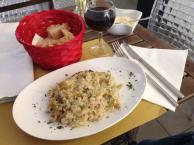
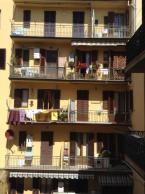
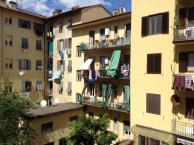
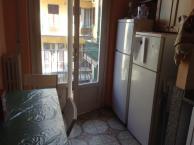

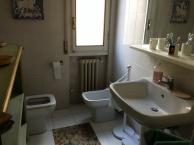
Dad Happy Easter Ally! We miss you!
Aunt Linda Hey Alex. Not sure how the tripe would fare for Easter dinner here but love your courage and thirst for knowledge and adventure. You have done and seen so much during your time there and being able to identify so many of these things from your readings and University courses must be so amazing! Happy Easter! Love Aunt Linda, Uncle Tom, Cole and Noah